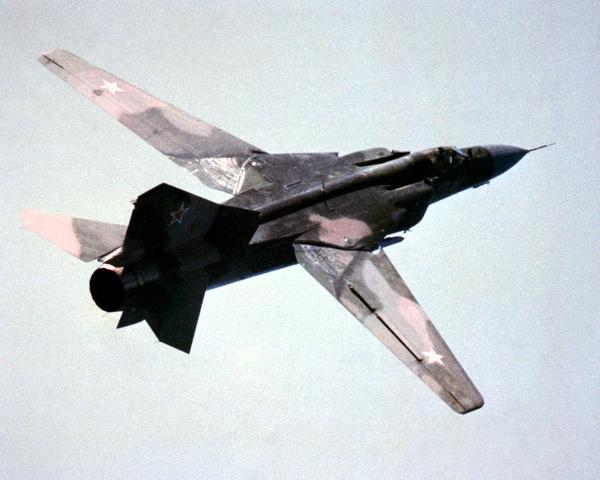 |
 |
Mig-23 Flogger
Meant as a point defense fighter, the Flogger offered a powerful radar, an infrared search and track system, a selection of radar and infrared guided weapons and tremendous speed (Mach 2.35) to counter its adversaries. The MiG-23 was designed in 1964-66 as a successor to the MiG-21. In addition to a much more powerful engine, the MiG-23's most significant new feature was its variable sweep wing. Like the USAF's swing wing F-111, the sweep of the wings could be changed in flight. Fully spread, this gives a shorter takeoff/landing roll while carrying a heavier weapons load. With the wings fully swept back, the MiG-23 has greater speed. The wing has three sweep settings: 16, 45, and 72 degrees. The prototype first flew in April 1967 and MiG-23s began entering operational service in 1971.
The aircraft is in widespread use in Eastern Europe and the Middle East. The MiG-23/27 FLOGGER series of aircraft has been used extensively by the former Soviet Union and its Warsaw Pact allies including Poland, Hungary, Bulgaria, East Germany, Rumania, and Czechoslovakia. Other countries including Libya, Syria, Egypt, India, Cuba, Algeria, Iraq, Afghanistan and North Korea have imported FLOGGERS.
The MiG-23 series served as fighter-interceptors, with a secondary capability of ground attack. The MiG-23BN and MiG-27 were fighter-bomber variations. The Flogger B is a standard interceptor. Other versions of this aircraft are: C--two seater; G--improved interceptor; and E--export. The MiG-23MLD FLOGGER K version was a modification of the MiG23ML FLOGGER G and incorporated improved avionics, armament, and aerodynamic features. The MiG-23MLD is the most advanced version of the Flogger. It features a different identification-friend-or-foe system, a more advanced missile capability and a distinctive notch in the leading edge of the wing to improve flight characteristics. More than 4,000 MiG-23/27s are estimated to have been built.
The wings are high-mounted, variable, swept-back, and tapered with blunt tips. There is one turbofan engine inside the body. There are rectangular, box-like air intakes forward of the wing roots and a single exhaust. The fuselage is long and tubular, except where intakes give a box-like appearance. It has a long, pointed nose and a stepped canopy. There is a large, swept-back, and tapered belly fin under the rear section. The tail is swept-back, has a tapered tail fin, has a curved dorsal in the leading edge and an angular tip. Swept-back, tapered flats have angular tips and are high-mounted on the fuselage.
MiG-23 aircraft acquired by the United States under the Foreign Materiel Acquisition/Exploitation program are designated as the YF-113.
Only historical note is being shot down in Libyan service by American F-14s from the carrier Kennedy. The MiG-23 also served during the conflict in Afghanistan.
Nickname: Chiborashka
Named for a Russian cartoon character that was always tripping over itself or otherwise falling down. Obviously not a well loved aircraft by it's crews.
| Description | ||
|---|---|---|
| Manufacturer: | A.I.Mikoyan Design Bureau | |
| Designation: | MiG-23 | |
| Version: | ||
| Nickname: | ||
| NATO reporting name: | Flogger | |
| Type: | Front-line variable swept wing fighter | |
| Crew: | 1 pilot | |
| Specifications | ||
| Length (with probes): | 17.05 m | 55 ft10.8 in |
| Height: | 4.35 m | 14 ft 3 in |
| Wingspan (min sweep angle): | 13.8 m | 45 ft 3 in |
| Wingspan (max sweep angle): | 7.4 m | 24 ft 3 in |
| Wingarea (min sweep angle): | 37.3 Sq m | 401 Sq ft |
| Wingarea (max sweep angle): | 24.2 Sq m | 260 Sq ft |
| Max T-O Weight: | 17900 kg | 39427 lb |
| Propulsion | ||
| No. of Engines: | 1 | |
| Powerplant: | Tumansky R27F2M-300 turbojet | |
| Thrust (each) | 10200 kgf | 22467 lb |
| Performance | ||
| Max range: | 1900km | 1181 mi |
| Max Speed at sea level: | 1350 km/h | 839 mph |
| Max Speed at high altitude: | 2500 km/h | 1554 mph |
| Service Ceiling: | 18000 m | 59016 ft |
| Max g-load: | 7 g | |







